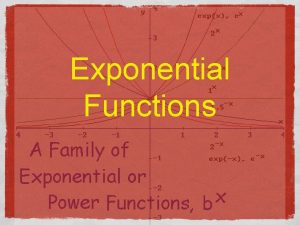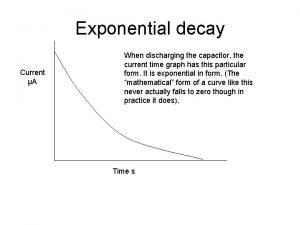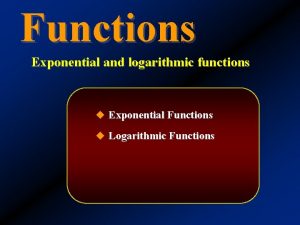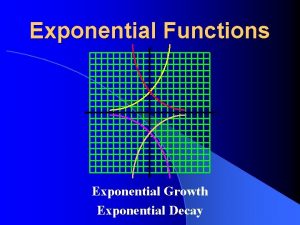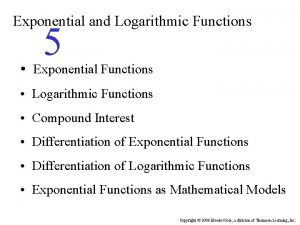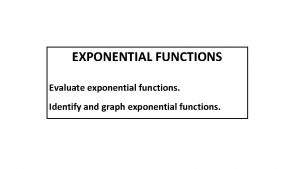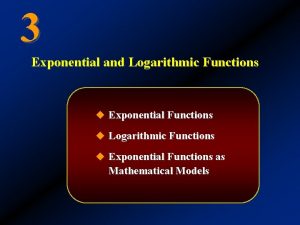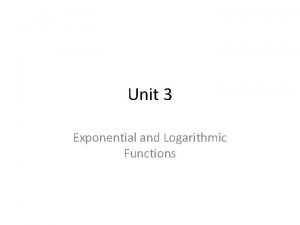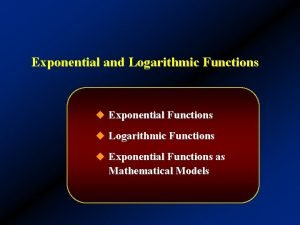Exponential Functions Warmup Exponential Funtion The exponential funtion














- Slides: 14

Exponential Functions

Warm-up

Exponential Funtion The exponential funtion f with base a is defined by: f (x) = x a where a > 0, a ≠ 1, and x is any real number. For instance, f(x) = 3 x and g(x) = 0. 5 x are exponential functions.

EVALUATING EXPRESSIONS: x 3 The value of f(x) = when x = 2 is 2 f(2) = 3 = 9 The value of f(x) = f(– 2) = x 3 – 2 3 The value of g(x) = g(4) = when x = – 2 is = x 0. 5 when 4 0. 5 x = 4 is = 0. 0625

Example: sketching exponential graph Example: Sketch the graph of f(x) = x -2 -1 0 1 2 f(x) (x, f(x)) ¼ (-2, ¼) ½ (-1, ½) 1 (0, 1) 2 (1, 2) 4 (2, 4) x 2. y 4 x 2 – 2 2

The graph of exponential funtion The graph of f(x) = ax, a > 1 is INCREASING over its domain x a, a>1 y 4 Range: (0, ∞) (0, 1) x 4 Domain: (–∞, ∞) Horizontal Asymptote y=0

The graph of exponential funtion The graph of f(x) = The graph of f(x) -x =a (fraction exponents) is DECREASING over its domain -x a y 4 Range: (0, ∞) (0, 1) x 4 Domain: (–∞, ∞) Horizontal Asymptote y=0

Your turn! Sketch the graph of the following exponential funtion: State the domain and range f(x) = x 2 f(x) = -x 5 f(x) = y y +3 y 4 4 4 x 7 y=3 2 (0, 1) Domain: (–∞, ∞) Range: (0, ∞) (0, 1) x x 4 4 Domain: (–∞, ∞) Range: (0, ∞) Domain: (–∞, ∞) Range: (3, ∞) x

Example 2 f(x) = Example: Sketch the graph of State the domain and range. y x 2 -1. f(x) = 2 x 4 Range: (1, ∞) 2 Range: (– 1, ∞) x Domain: (–∞, ∞) y = – 1

Example 3 Example: Sketch the graph of State the domain and range. f(x) = 2 x y 4 Domain: (–∞, ∞) Range: (0, ∞) x – 2 2 -x 2.

Transformation of exponential graphs f(x) = 2 Example: Sketch the graph of State the domain and range. f(x) = 2 f(x) = x+2 x 2 ( 2 2 f(x) = 2 x+2 y ) (4) X-intercept x+2 f(x) = 2 x (0, 4)4 Range: (0, ∞) 2 x y =0 Domain: (–∞, ∞) Range: (0, ∞)

Example 3 f(x) = -2 x. Example: Sketch the graph of State the domain and range. f(x) = 2 x y 4 x – 2 2 Domain: (–∞, ∞) Range: (0, -∞) f(x) = -2 x

f(x) = Graph of x e y 6 4 2 x – 2 2 x -2 -1 0 1 2 f(x) 0. 14 0. 38 1 2. 72 7. 39 The irrational number e, where e ≈ 2. 71828… is used in applications involving growth and decay.

Your turn Graph and state the domain and range of the following functions: f(x) = -x 2 + 3 f(x) = 2 x 32 f(x) = y y -1 y 4 4 x 9 4 y=3 2 (0, 1) x 4 Domain: (–∞, ∞) Range: (3, ∞) Domain: (–∞, ∞) Range: (0, ∞) (0, 0) 4 Domain: (–∞, ∞) Range: (-1, ∞)
